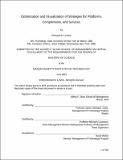| dc.contributor.advisor | Michael Cusumano. | en_US |
| dc.contributor.author | LeVine, Richard B. (Richard Barry), 1959- | en_US |
| dc.contributor.other | Massachusetts Institute of Technology. Management of Technology Program. | en_US |
| dc.date.accessioned | 2005-05-19T15:33:21Z | |
| dc.date.available | 2005-05-19T15:33:21Z | |
| dc.date.copyright | 2003 | en_US |
| dc.date.issued | 2003 | en_US |
| dc.identifier.uri | http://hdl.handle.net/1721.1/16988 | |
| dc.description | Thesis (S.M.M.O.T.)--Massachusetts Institute of Technology, Sloan School of Management, Management of Technology Program, 2003. | en_US |
| dc.description | Includes bibliographical references (leaves 155-158). | en_US |
| dc.description | This electronic version was submitted by the student author. The certified thesis is available in the Institute Archives and Special Collections. | en_US |
| dc.description.abstract | This thesis probes the causal elements of product platform strategies and the effects of platform strategy on a firm. Platform strategies may be driven by internal or external forces, and the lifecycle of a firm and of a platform strategy evolve over time in response to both the needs of the firm and the changes in the external environment. This external environment may consist of a "platform ecology," in which the platform strategies of firms affect one another. These effects may be positive, buoying revenues, or negative, eliminating markets and appropriating value. The thesis assumes that a company whose strategy is to produce complements or services for another firm's platform may be said to have a platform strategy, and further assumes that a company with a modular platform strategy built primarily for its own internal use may also be said to have a platform strategy. Finally, this thesis will demonstrate example visualization techniques that make the nature of such platform strategies more apparent. This thesis asks and tries to answer a few key questions: ** What comprises the elements of a platform strategy? ** What kinds of companies adopt these strategies? ** What circumstances drive adoption? ** What outcomes can be expected? ** What happens to such a strategy over time? The thesis asserts and attempts to prove these hypotheses: ** Platform Strategies of one firm can influence those of many other firms, by direct effect on the other firms, or by simple economic benefit example. ** Return on Investment (ROI) is influenced by these strategies. ** Beyond ROI and thus Profit fluctuations, company survival, in an evolutionary Darwinian sense, may depend on these strategic choices. | en_US |
| dc.description.statementofresponsibility | by Richard B. LeVine. | en_US |
| dc.format.extent | 160 leaves | en_US |
| dc.format.extent | 3060006 bytes | |
| dc.format.extent | 3089646 bytes | |
| dc.format.mimetype | application/pdf | |
| dc.format.mimetype | application/pdf | |
| dc.language.iso | eng | en_US |
| dc.publisher | Massachusetts Institute of Technology | en_US |
| dc.rights | M.I.T. theses are protected by copyright. They may be viewed from this source for any purpose, but reproduction or distribution in any format is prohibited without written permission. See provided URL for inquiries about permission. | en_US |
| dc.rights.uri | http://dspace.mit.edu/handle/1721.1/7582 | |
| dc.subject | Management of Technology Program. | en_US |
| dc.title | Optimization and visualization of strategies for platforms, complements, and services | en_US |
| dc.type | Thesis | en_US |
| dc.description.degree | S.M.M.O.T. | en_US |
| dc.contributor.department | Management of Technology Program. | en_US |
| dc.contributor.department | Sloan School of Management | |
| dc.identifier.oclc | 54032155 | en_US |
